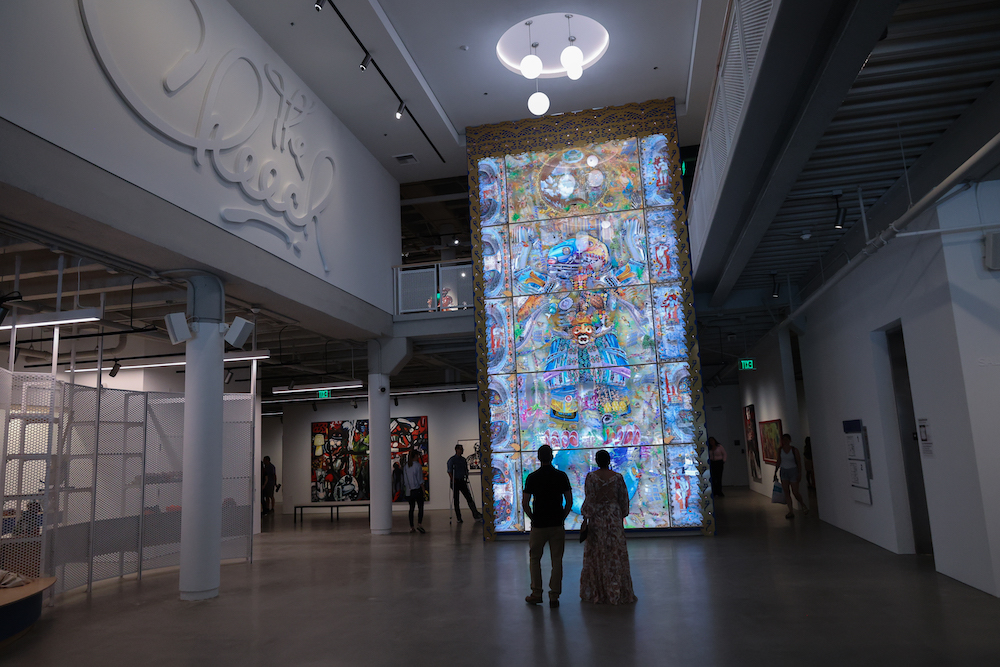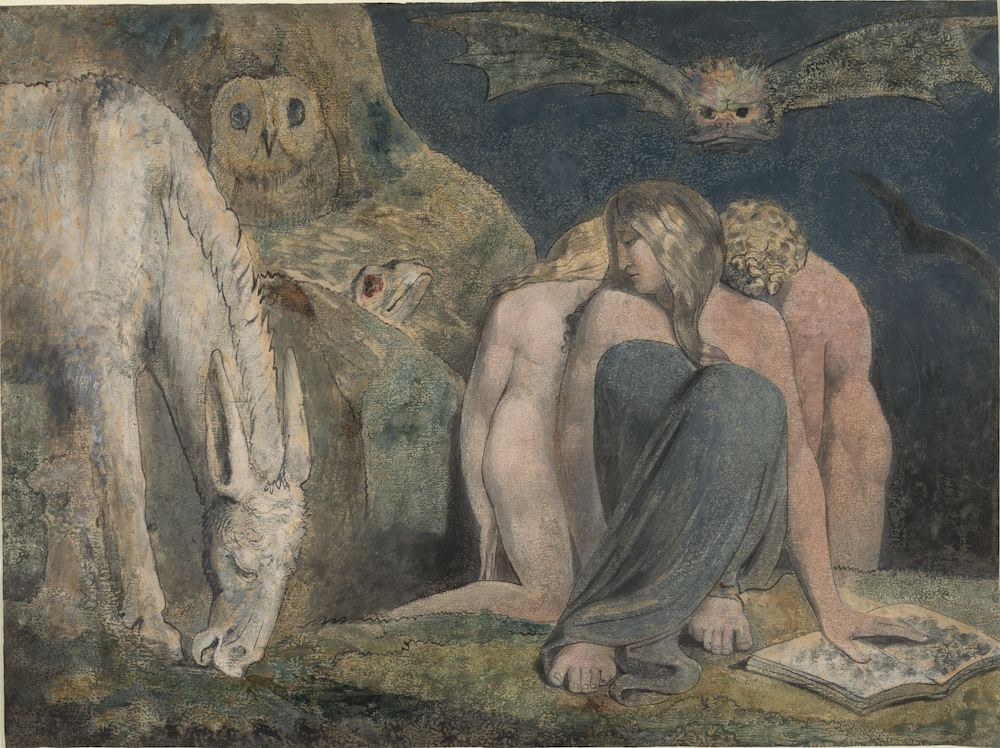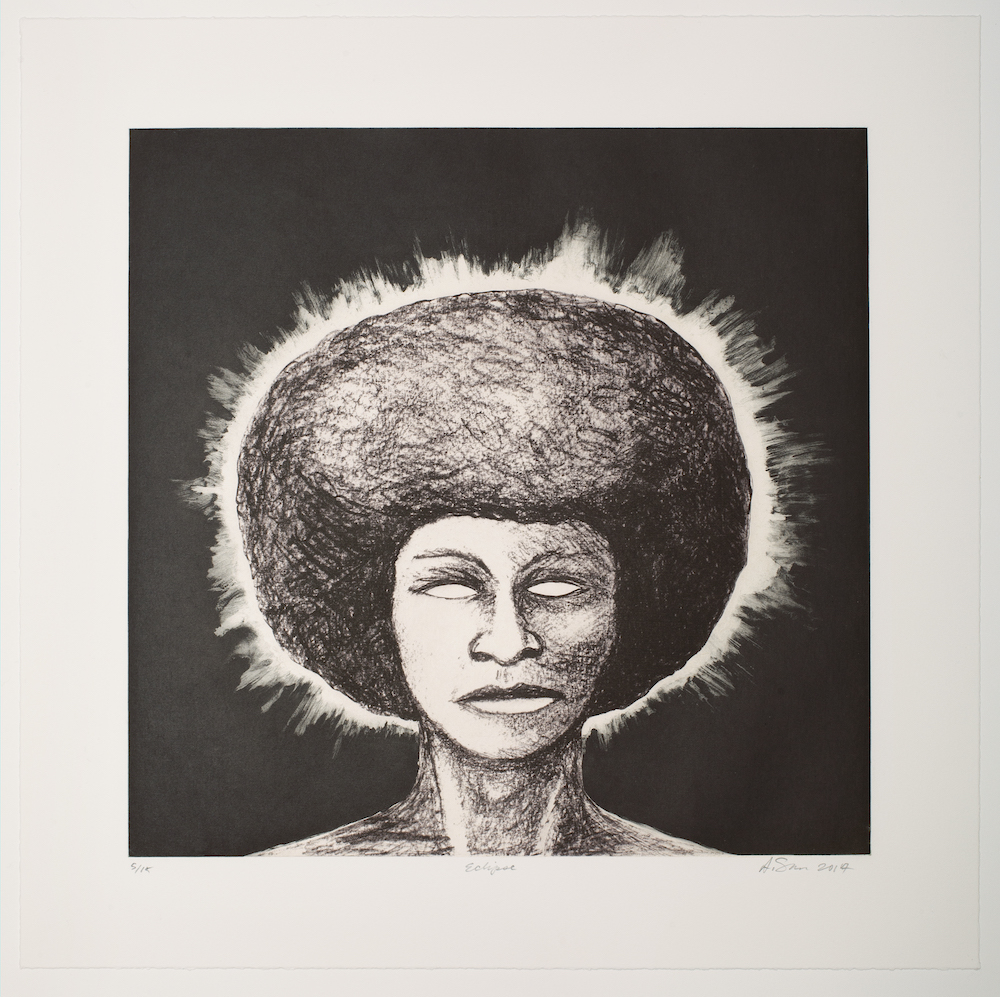The Cheech Is Here
While many museums are opening exhibitions long delayed by COVID, one is unveiling a completely renovated building with a new focus. That would be the Cheech Marin Center for Chicano Art & Culture, or The Cheech, in Riverside. Part of the Riverside Art Museum, it opened June 18 in a renovated Modernist building, formerly a public library, at a cost of $13 million.
The two inaugural shows are wonderful introductions to Chicano art. “Cheech Collects” (through June 18, 2023) is a selection of 120 works from Marin’s collection, both from his gift of 500 works to the museum and the approximately 200 he retained. As a third-generation Mexican American, this art spoke to him. Four decades ago, when he first began collecting, the field was new and considered offbeat. “Other museums, they didn’t know what it was,” Marin said during the preview. “You can’t love or hate Chicano art till you see it. We need more people to see it.” He also believes that Chicano artists will be encouraged seeing these works in a museum. The sentiment was echoed by Sandy Rodriguez, one of the artists in the show. “To be able to come to a museum and see generations of Chicano art,” she said, “is absolutely stunning.”
The sections are arranged thematically, such as portraits and abstraction, but I found the flow was seamless. One of the most striking portraits is that of Marin himself, in a medium-sized painting by Eloy Torrez, titled It’s a Brown World After All. Casually dressed in a polo shirt with a jaunty paper crown atop his head, Marin appears against a background of a turbulent bay, with seagulls floating in the air. Another favorite is Frank Romero’s The Arrest of the Paleteros, a large narrative painted in a Magic Realist style, this one rooted in the reality of LA Police arresting vendors for selling ice pops. In the background are palm trees and Echo Park, looking a bit as if on fire. Other artists include Patssi Valdez, Carlos Almaraz, Judithe Hernández and Gilbert “Magú” Luján.
Don’t miss the other exhibition, on the second floor, the riotous “Collidoscope,” a retrospective of the brothers Einar and Jamex de la Torre, who often use art glass and readymade objects in their sculpture and assemblages. A centerpiece of the show is the epic installation Colonial Atmosphere, with a giant Olmec head as a lunar lander, interweaving themes of pre-colonial Mexican art with contemporary pop culture. More recently the artists have been creating giant lenticulars, playing off Catholic altars and iconography.
At the end of the preview presentation, Riverside Mayor Patricia Lock Dawson presented Marin with the key to the city—he seemed genuinely pleased to get it.

Interior of The Cheech; image courtesy of the Riverside Art Museum
More Cultural Treasures
We often forget what a wealth of art and culture the museums, libraries and universities of the greater Los Angeles area hold. Several more excellent exhibitions opened recently—three of them drawing from the institution’s own collection.
At The Huntington, “100 Great British Drawings” (through Sept. 5) just opened. Intended to celebrate the museum’s 100th anniversary in 2020, it’s now two years late, and you know why. Curated by Melinda McCurdy, this is a kind of top hits of British drawing and watercolor from The Huntington’s own collection, which totals 12,000 works and is considered the best collection in this field outside Britain. Honestly, who knew? The show focuses on work from the 17th through the mid-20th centuries, and it’s a knockout. Don’t miss the very creepy William Blake illustration for Milton’s Paradise Lost, showing the battle between Satan and his son Death with a sad Sin (as a female figure, natch) in between them.

100 Great British Drawings: William Blake (1757 — 1827), Hecate or The Night of Enitharmon’s Joy, 1795. Planographic color print with pen and ink and watercolor on wove paper, 16 3/8 x 22 in. The Huntington Library, Art Museum, and Botanical Gardens.
In Midtown LACMA is actively programming the Broad Art Museum and the Resnick Pavilion, as the older sections lie in rubble. I had a glimpse of the ruins one afternoon when the gates were open, and it was sad. In the Resnick are two fascinating and also rather complementary shows, “Archive of the World: Art and Imagination in Spanish America, 1500–1800” (through Oct. 30) and “The Portable Universe: Thought and Splendor of Indigenous Colombia” (through Oct. 2). The first comprises some 90 objects from LACMA’s growing collection of Spanish American art, including paintings, textiles, and objects and furnishings. Highlights include a chalice in intricate silver metalwork, incorporating bird feathers in small decorative inserts around the base. I was charmed by one painting by Miguel Cabrera showing a Spanish father and mixed-raced mother, embracing an albino child (their child), in a genre known as “casta” painting. While these paintings seem to exoticize life in the “New World,” they were also very sympathetic to interracial families.
“The Portable Universe” is a deep dive into the ancient arts of Colombia—400 objects including sculptures, carvings and metalwork, many of them loans from the Museo del Oro in Bogota. Sounds and music float through the air here, and no dates are on the individual labels, giving us the sense of timelessness. At first, I found this a bit irritating—not right for a museum—but finally I stopped being so analytical and just enjoyed looking at object after object.
Other shows worth taking in are in Westwood and up Ventura way. At the Hammer Museum “Drawing Down the Moon” (till Sept. 11) draws from its own collection and from other LA institutions. Curated by Allegra Pesenti, the show is a witty look at how artists have viewed our nearest celestial neighbor, the Moon. Meanwhile, one of my favorite artists Lynn Hanson, has a show through July 10 at the Santa Paula Art Museum—a small gem of a museum in a charming town. “Fieldnotes” reflects three decades of her drawings and watercolors—the small ones made as she took her daily walks along the Pacific Coast. I especially love her charcoal drawings of birds, snakes and octopi on antique maps, floating over the land as if they’re reclaiming some of what’s been taken from them.

Drawing Down the Moon: Alison Saar, Eclipse, 2017. Etching, aquatint. Sheet: 18 x 18 in. (45.7 x 45.7 cm). UCLA Grunwald Center for the Graphic Arts, Hammer Museum. Purchased with funds provided by the Marcia Weisman Endowment Fund © 2017 Alison Saar


